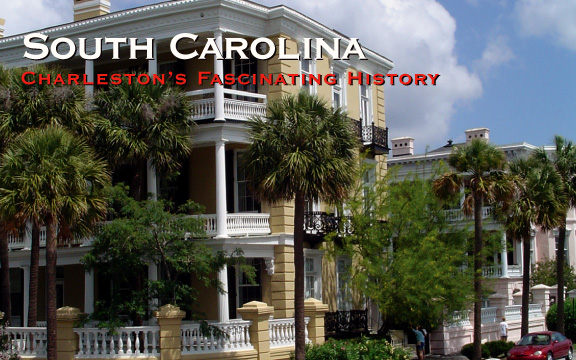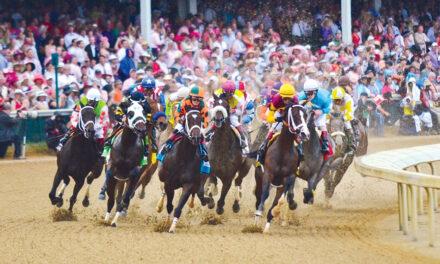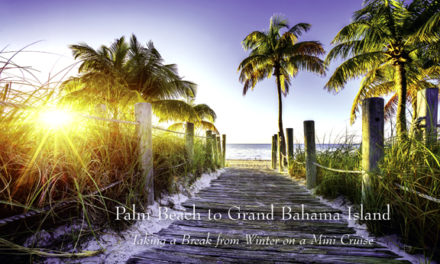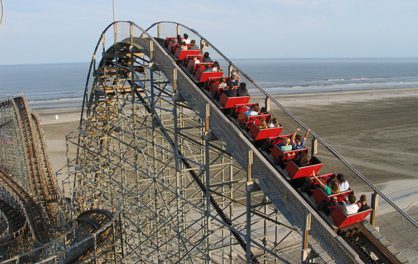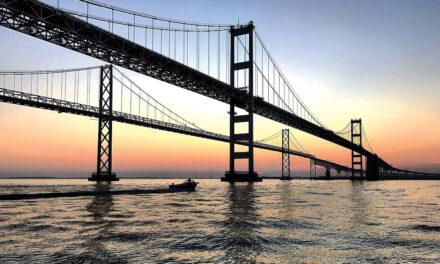South Carolina
Charleston’s Fascinating History
Published in the Summer 2005 Issue of Canadian World Traveller
Text: Excerpts from Michelin Green Guide USA East and Michelin Must Sees The Carolina Coast (www.viamichelin.com)
Photos: M. Morcos, Michelin Guides and courtesy of South Carolina Department of Parks, Recreation and Tourism (www.discoversouthcarolina.com).
Thoughts of the South Carolina Coast inevitably bring to mind palmetto trees and moss-draped live oaks, broad stretches of pale sand, and the handsome city of Charleston, where the area’s history began.
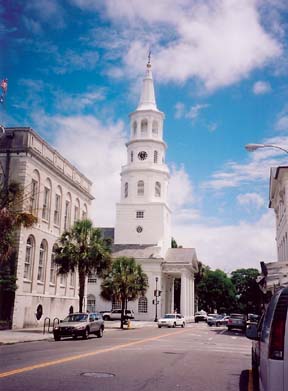 Anchoring the coast on a narrow peninsula of land where the Ashley and Cooper rivers converge, Charleston was born in 1570 when a group of English colonists landed on the western bank of the Ashley River. The swampy settlement they named Charles Towne (after King Charles II) was so plagued by disease and hunger during its first decade that the colonists moved the town in 1680 to a better location on the peninsula across the river.
Anchoring the coast on a narrow peninsula of land where the Ashley and Cooper rivers converge, Charleston was born in 1570 when a group of English colonists landed on the western bank of the Ashley River. The swampy settlement they named Charles Towne (after King Charles II) was so plagued by disease and hunger during its first decade that the colonists moved the town in 1680 to a better location on the peninsula across the river.
This new location, surrounded, on three sides by water, was a natural site for trade. The town grew to be the fifth-largest city in colonial America by 1690, supported by a wealthy merchant class. Rice, indigo and cotton thrived along the coast in the low country’s temperate, humid climate, and soon hundred of plantations-largely dependent on slave laborers for their prosperity- dotted the land.
The Civil War, which heard its first shots in Charleston Harbor on April 12, 1861, changed the city forever. By war’s end, the thriving part had been shelled into a virtual ghost town. As a result of the abolition of slavery and the poverty that besieged the South after the war, the region’s plantation economy gradually disintegrated.
Like any gracious Southern lady, Charleston always welcomes visitors. Any season is a good one to bask in the area’s wide sandy beaches, revel in its history architecture, and breathe its magnolia-scented air.
One of the Carolina’s top tourist destinations, Charleston boasts the fourth largest container port in the U.S. The City also claims tow venerable academic institutions: the College of Charleston was founded in 1770; and The Citadel Military College of South Carolina enrolled its first cadets in 1842.
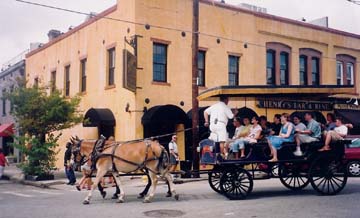 In recent decades, the city has again revived its downtown, first with the annual Spoletto performing-arts festival (late May), started in 1977 by Maestro Gian Carlo Menotti as the counterpart to his Festival of Two Worlds in Spoletto, Italy; then in the late 1980’s with the opening of the luxury complex now known as Charleston Place (130 Market St.). In spring 2000 a new aquarium opened along the waterfront.
In recent decades, the city has again revived its downtown, first with the annual Spoletto performing-arts festival (late May), started in 1977 by Maestro Gian Carlo Menotti as the counterpart to his Festival of Two Worlds in Spoletto, Italy; then in the late 1980’s with the opening of the luxury complex now known as Charleston Place (130 Market St.). In spring 2000 a new aquarium opened along the waterfront.
Any visit to the city should begin on the lower tip of the 5.2 square-mile peninsula formed by the Ashley and Cooper rivers. Named after Anthony Ashley Cooper, one of the first eight owners that were awarded Carolina’s land to be divided. This is the Historic District, a 3* site in the Michelin Green Guide, heart of Charleston since 1680, which encompasses the area specified in the original 17c Grand Modell, of city plan. As you stroll the palmetto-studded streets lined with gas lanterns, it’s easy to imagine the colonial days when Charleston was London in miniature – a prosperous aristocratic city whose gentry built many of the home you see today.
The city’s distinctive contribution to American architecture is based on a typical West Indian design (many of Charleston’s early settlers were planters from Barbados).
Walking-tour booklets are available at the Visitor Center (375 Meeting St.) and at the Historic Charleston Foundation Museum Shop (108 Meeting St.).
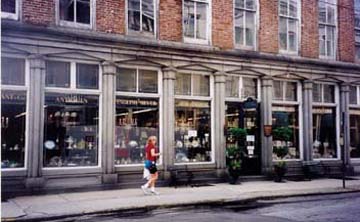 Along the way, colorful Rainbow Row (79-107 E. Bay St.) showcases the largest intact cluster of Georgian row houses in the U.S.; the earliest dwellings here date to 1680. A few blocks away, King Street, Charleston’s major commercial thoroughfare since colonial days still brims with shops, inns, restaurants and pricey antique shops.
Along the way, colorful Rainbow Row (79-107 E. Bay St.) showcases the largest intact cluster of Georgian row houses in the U.S.; the earliest dwellings here date to 1680. A few blocks away, King Street, Charleston’s major commercial thoroughfare since colonial days still brims with shops, inns, restaurants and pricey antique shops.
Next stop on your journey is The Battery. If you’ve seen any photographs of Charleston, chances are you’ve seen the Battery. Indeed, this historic district landmark defines the tip of Charleston’s peninsula. Long considered a strategic point from which to defend the city, the Battery takes its nickname from its military service. The site is protected by a high seawall that lines the Cooper River side of Charleston harbor; this wall replaced the masonry structured built in 1700 to fortify the city. Strengthened over the years to ward off hurricanes the wall became known as the High Battery for the gun emplacement stationed here during the War of 1812. After the war ended in 1865, the Battery reverted to more peaceful uses as a park.
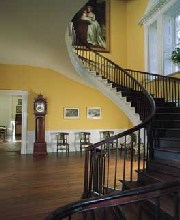 If you see one historic house in Charleston, make it Nathaniel Russell House. Sister property to the Aiden-Rhett House, the Nathaniel Russell House has been restored to its 19c glory after hurricane Hugo blew through town in 1989. The difference between the two houses is what separates conservation from restoration. The latter, unlike other homes that have been restored to their former elegance, the Aiken-Rhett House has been preserved as it appeared in 1860. Other houses that will satisfy your architectural needs are: The Edmondston-Alston House and the Heyward-Washington House
If you see one historic house in Charleston, make it Nathaniel Russell House. Sister property to the Aiden-Rhett House, the Nathaniel Russell House has been restored to its 19c glory after hurricane Hugo blew through town in 1989. The difference between the two houses is what separates conservation from restoration. The latter, unlike other homes that have been restored to their former elegance, the Aiken-Rhett House has been preserved as it appeared in 1860. Other houses that will satisfy your architectural needs are: The Edmondston-Alston House and the Heyward-Washington House
A trip to Charleston just isn’t complete without a stroll through the Old City Market. Stretching from Meeting Street to the river along Market Street, the three block long row of open-air sheds with arched openings fills daily with vendors selling everything from grass baskets to T-shirts. Despite what you might have heard, the Old City Market was not the site of slave auctions. That dubious distinctions goes to the Old Slave Mart, located on cobblestone Chalmers Street.
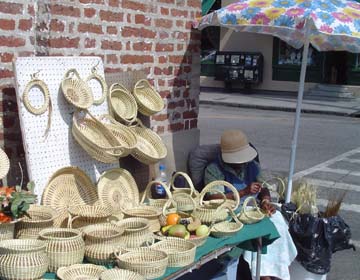 In the Old Market and along the streets in Charleston, you will see black women making and selling a wide variety of coiled grass baskets. This craft came to South Carolina with slaves from West Africa 300 years ago. During the pre-civil War plantation era, slaves stored foodstuffs and winnowed rice in baskets made by coiling marsh grass with strips of palmetto leaves.
In the Old Market and along the streets in Charleston, you will see black women making and selling a wide variety of coiled grass baskets. This craft came to South Carolina with slaves from West Africa 300 years ago. During the pre-civil War plantation era, slaves stored foodstuffs and winnowed rice in baskets made by coiling marsh grass with strips of palmetto leaves.
This art from, passed down from generation to generation, is now prized as a dying folk art. Labor-intensive sweet grass baskets take anywhere from 12 hours to 3 months to make, a fact that adds to their value as well as to their price.
In colonial times, the river served as the main route to the stately plantations that faced the Ashley River. By land, an arduous back road followed part of an ancient Cherokee Indian Trail. Today, tree-lined Highway 61 (Ashley River Road) provides easy access to the plantations, a 20 mn drive southwest of Charleston.
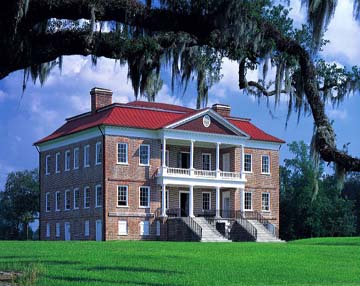 Here you will find some of the most beautiful plantations like Drayton Hall (www.draytonhall.org), Magnolia Plantation and Gardens and Middleton Place (www.middletonplace.org).
Here you will find some of the most beautiful plantations like Drayton Hall (www.draytonhall.org), Magnolia Plantation and Gardens and Middleton Place (www.middletonplace.org).
Since its founding in 1670, Charleston has known some pretty momentous events. The first great victory of the Revolution was won here at Fort Moultrie in 1776 (www.nps.gov/fomo), and the first shots of the civil war fired at Fort Sumter in 1861 (www.nps.gov/fosu).
More recently, in 2000, the Civil War-era submarine H.L Hunley (www.hunley.org) was raised from the depths of the harbor.
Charleston Travel Guides
There’s much more information about the city in the Michelin Green Guide USA East and Michelin Must Sees The Carolina Coast (www.viamichelin.com). But don’t just read about it – come and use the guides to discover Charleston’s fascinating history for yourself.
For More Info:
South Carolina Department of Parks,
Recreation and Tourism
1205 Pendleton Street
Columbia, South Carolina 29201
Tel.: 803-734-1700
Email: See Website
Website: www.discoversouthcarolina.com

